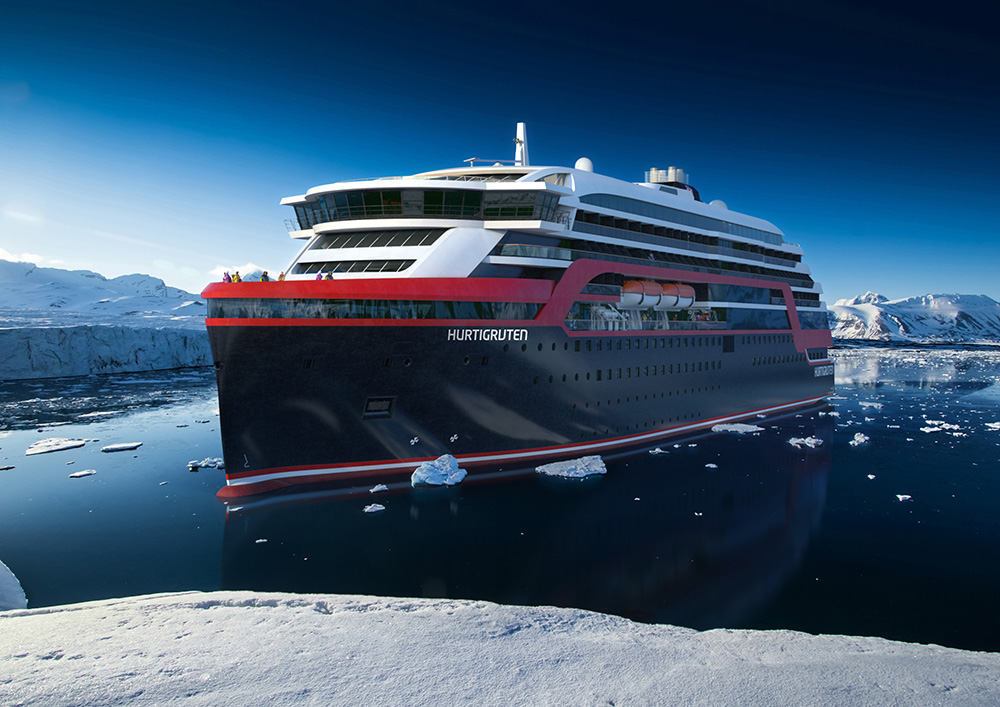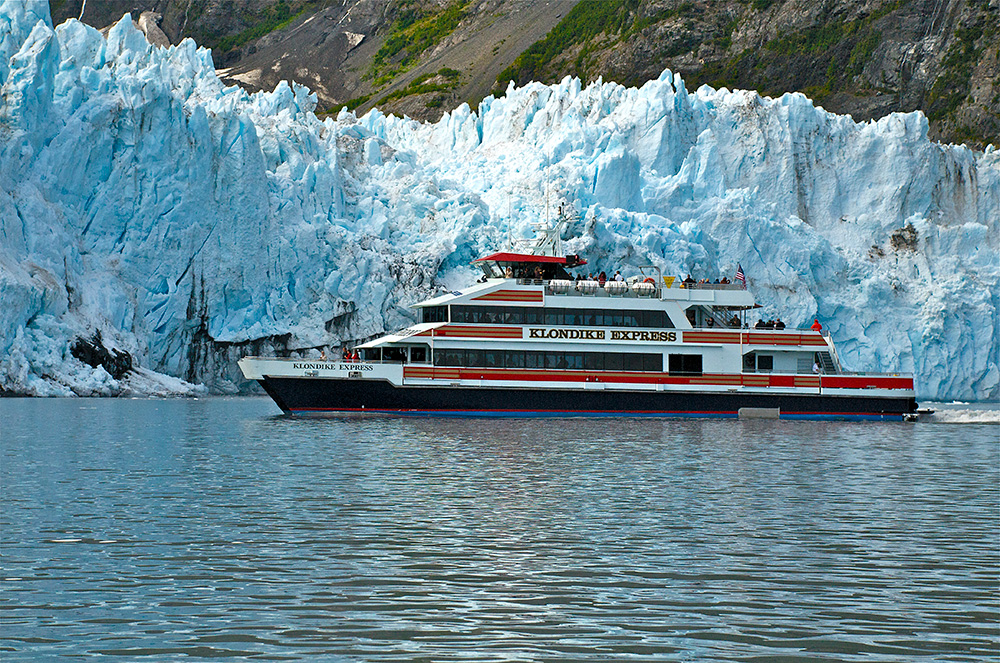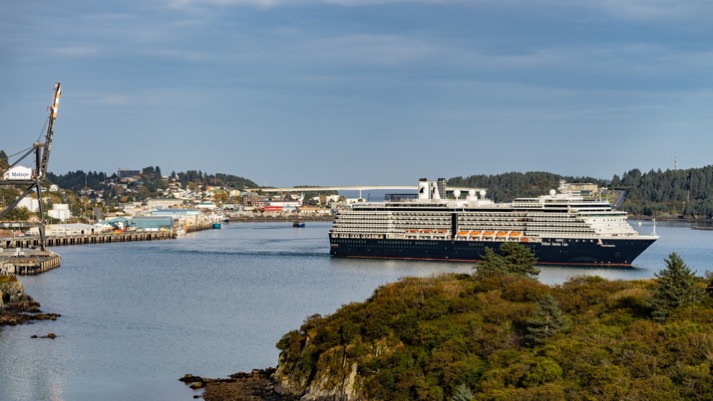
Hurtigruten will send its new, hybrid-powered expedition ship, the Roald Amundsen, through the Northwest Passage next year and then on an 18-day adventure from Nome to Vancouver.
The Roald Amundsen is one of two ships designed by Rolls-Royce that will use a new and environmentally sustainable hybrid technology.
“These groundbreaking expedition ships will revolutionize adventure travel at sea. We are combining Hurtigruten’s more than 120 years of know-how with cutting-edge technology and design and a strong commitment to sustainability to offer the modern-day adventure traveler unprecedented experiences,” says Hurtigruten CEO Daniel Skjeldam.
These new ships will reduce the fuel consumption by approximately 20 percent. For the first time, fully electric propulsion on a passenger ship will be possible. The decision to invest in a hybrid solution is an important milestone in Hurtigruten’s goal of sailing fully electric expedition ships in the Arctic and Antarctic. These ships, to be constructed at Kleven Yards in Norway, will be the world’s first expedition ships with true hybrid propulsion.
The future of maritime travel is, without a doubt, silent and emission-free. “We will use our new expeditionary ships as groundbreakers for this new technology and show the world that hybrid propulsion on large ships is possible today,” says Skjeldam.
Hurtigruten has named the first two ships MS Roald Amundsen and MS Fridtjof Nansen after the two most influential Norwegian polar pioneers from the era when the company itself first started offering adventure travels. As of 2016, it will be 105 years since Roald Amundsen became the first person in the world to plant his flag on the South Pole; 128 years since Fridtjof Nansen skied across Greenland; and 120 years since Richard With, Hurtigruten’s founder, first started exploration tourism in the Arctic.
“What could be more natural and appropriate than to name our new ships after these inspiring trailblazers?” asked Daniel Skjeldam.
Sustainable and soundless sailings
MS Roald Amundsen and MS Fridtjof Nansen will showcase the very latest in innovative and environmentally friendly technology. This new hybrid technology will make sailing with electric propulsion for 15–30 minutes a reality – but the total reduction in fuel consumption is the main gain. This technology, in combination with the construction of the hull and effective use of electricity on board, will reduce the fuel consumption and CO2 emissions by 20 percent. This amounts to more than 3,000 metric tons of CO2 per year. A passenger ship requires an enormous amount of energy to operate, and so far, there have been no technologies able to fulfill the requirements of a fully electric ship. Hurtigruten’s new ships will likely be the first in the world to utilize this advanced technology.
“Being able to sail using only electrical power is not only a great benefit to the environment, it will also enhance the impact of experiencing nature for the guests … Imagine sailing silently along the ice edge in the Arctic or Antarctica, or along the banks of the Amazon. That is truly unique and exceptional,” said Skjeldam.
The hybrid ships will be constructed in two phases. The first ship, which will be ready in 2019, will be equipped with an auxiliary electric engine. The second ship will be built with a full-fledged hybrid engine that can power the entire ship for longer periods of time and across greater distances, into fjords, and most important, in vulnerable areas.
State-of-the-art Scandinavian design
The MS Roald Amundsen and MS Fridtjof Nansen will also set a new standard in interior design and onboard customer experience. The aura of the period of the great exploration expeditions will be recreated and combined within a framework of modernity, and the ships will be of first-rate quality and deliver exceptional comfort.
The ships’ interiors will mirror the breathtaking waters and landscapes in which the expedition ships will sail. They will be stylish, yet down-to-earth, characterized by an innovative Scandinavian approach to interior design. Materials will be predominantly Norwegian and be inspired by nature, and guests will appreciate the distinguished environment created by the innovative use of granite, oak, birch, wool and other natural materials.
“We don’t take guests ‘cruising.’ We take them ‘exploring.’ A suitable onboard environment and atmosphere is essential to broaden and deepen the immersive experience of nature a Hurtigruten exploration experience constitutes,” says Skjeldam.
The ships will have large observation platforms on several decks for guests to get up close to nature and wildlife. Six of 10 cabins will have their own balconies, and two of every 10 will be suites. The vessels will have three restaurants, with menus reflecting local flavors and destinations. A special pool deck will include infinity pools, hot tubs and cocktail bars.
MS Roald Amundsen and MS Fridtjof Nansen facts
- Are a new class of specially constructed ships designed for voyages in polar waters
- Have strengthened hulls for traversing ice
- Designed by Rolls Royce and built by Kleven Yards
- Will feature innovative Scandinavian design, large observation platforms, infinity pools, and several other yet-to-be-disclosed expedition features
- Number of passengers per ship: Approximately 600
- Number of cabins per ship: Approximately 300
- Also adapted to service the route along the Norwegian coast
- Dimensions (exterior) per ship:
- Length: 459 feet
- Width: 77 feet
- Height: 95 feet
- Depth: 17 feet
Hybrid technology facts
- Makes fully electric propulsion an option for longer periods of time
- New battery technology contributes to a significant reduction of CO2from ships
- New solutions will contribute to a 20% reduction of fuel consumption. In total, the two new ships will have a reduced CO2emission of 6,400 metric tons per year compared to traditional ships. To put this into perspective, 6,400 metric tons is the same amount of yearly emissions created by 5,540 new cars.



